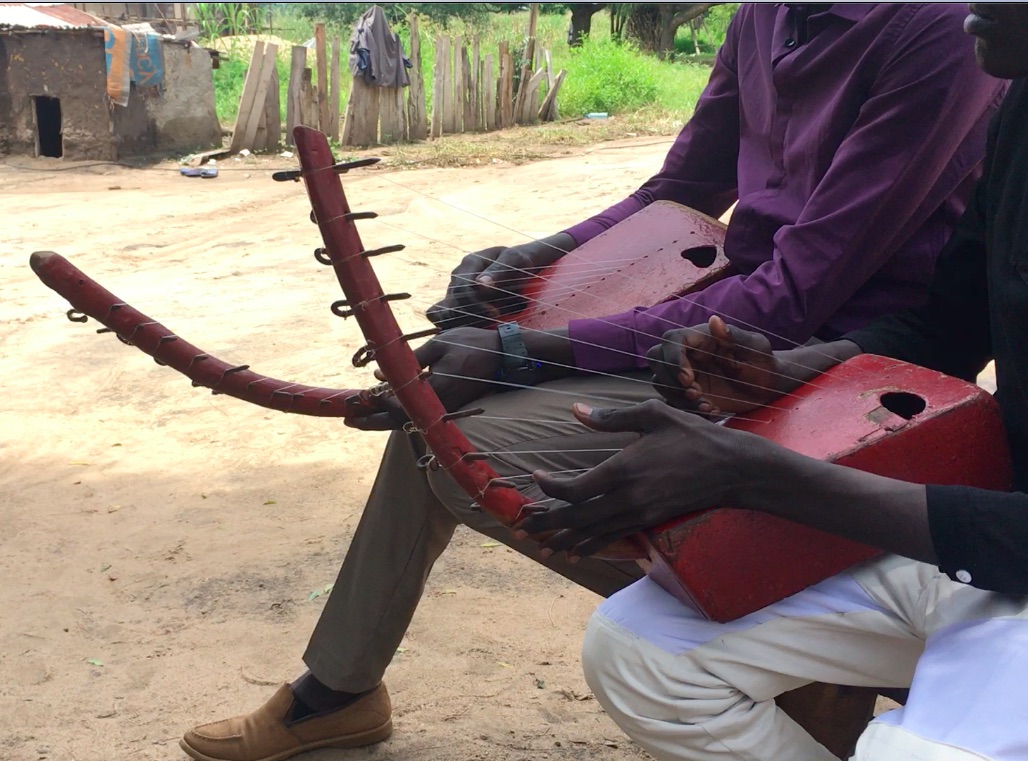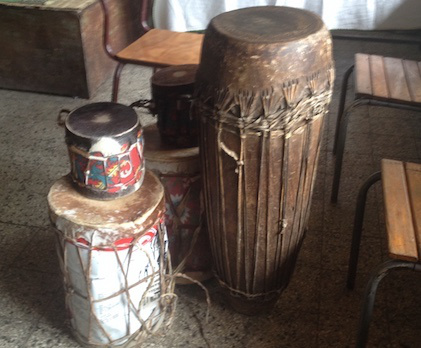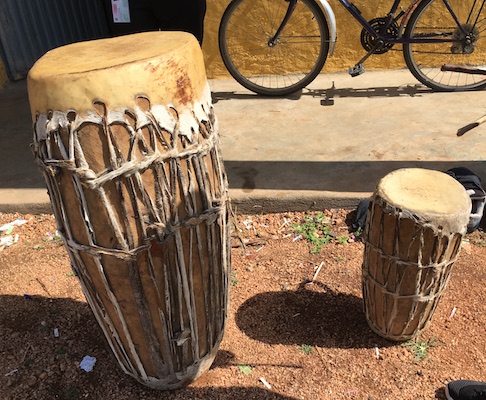Musical Instruments
With the diversity of peoples in Northeast Africa, there is also a great diversity of instruments. Some, such as the 1-string fiddle or the lyre, are widely diffuse throughout the area while others, such as the Lamellophone, are only found in certain regions. This list is open to expansion but for now contains the most popular instruments in Ethiopia as well as instruments typical of the Ethio-South Sudanese border, laid out in alphabetical order.
Adungo
The adungo is a bow harp made from wood, nylon strings, and metal pegs. Eastern Nuer on the Ethio-South Sudanese border adopted the instrument from a similar instrument called the adungu from the Acholi and Alur in Uganda. Nuer musician Lim Chuol has been hugely influential in popularizing this instrument among Ethiopian Nuer. He developed his own playing technique, added strings, and conducts classes for young people on the Ethiopian side of the border. He also developed three different sizes of the instrument: the bass, the melody (a mid-sized one), and the tenor (the smallest one). People usually tune these instruments to the anhemitonic pentatonic or diatonic scales. Church congregations such as the Seventh-Day Adventist Nuer church sometimes use these instruments to accompany their hymn singing.


The playlist below includes recordings from one of the the Nuer Seventh Day Adventist Churches in Gambella. In the first video, Kim Hoth and Kom Bakoak play the melody and tenor adungo while singing a hymn before the start of the service. Then, Hoth Tut leads the entire ensemble in accompanying congregational singing during service. In the last video, Lim Chuol demonstrates the bass adungo.
Begena (በገና)
Known as the Harp of King David, the begena has 10 strings and a distinctive buzzing sound created by the string vibrating against the instrument body. This instrument is almost exclusively associated with the Ethiopian Orthodox Church and is used for personal meditation and prayer. These songs are known as mezmur (መዝሙር), an Amharic term used specifically for religious music (as opposed to zefen (ዘፈን), which refers to secular music.)
Buul
"Buul" is a term that the Anywaa and Nuer use for drums. In Gambella, both ethnic groups use a similar construction style. The Anywaa specify three different types of buul: the small one (called aneedo), the medium one (called odoola), and the big one (also called buul; this means that "buul" may refer to drums generally or to the big drum specifically, depending on context).


Here is an example of the popular Anywaa rhythm, the agwaa-ga, demonstrated by Ojho and Apay in Gambella wereda.
Mha Chang, music producer and owner of Goa Ni Mal Studio, demonstrates on the Nuer buul in Newland neighborhood of Gambella wereda.
Krar (ክራር)
The krar is a 5-6 stringed pentatonically-tuned bowl lyre. It is a well-known instrument in Ethiopia and has many iterations across northeast Africa, including in Sudan, Eritrea, and southern Egypt.
In Ethiopia, the krar is a core member of the traditional bands and theatre troupes. The strings were formerly made from animal gut but have since been replaced by nylon. An electrified krar is also standard in may urban performances.
The krar has two playing techniques, plucked and strummed. In urban settings, I have mostly seen players use a variety of strummed techniques, selectively muting strings with their fingers in order to obtain a defined melody. Yahalem Nod Negussie, krar player at YOD Abyssinia in Addis Ababa, even occasionally plays the strings with his mobile phone to vary the timbre.
Generally, however, the krar is played with the left hand, and it is tuned pentatonically (and must be retuned if the player is switching to a different k'ignit.) If the krar has 6 strings, the remaining string is tuned in an octave to the tonic note (e.g. in tizita, it would be C D E G A C).
One of the most famous krar players is perhaps the late Asnaketch Worku. The following recording features her playing both plucked and strummed technique as she sings the song, "Inde Eyerusalem" (እንደ ኢየሩሳሌም).
Masīnk'o (ማሲንቆ)
The masīnk'o is a 1-stringed fiddle that is played by several different ethnic groups in northern and central Ethiopia and neighboring Eritrea, including the Amhara and Oromo. It is the instrument of choice for the azmari, solo singers in Amhara culture who often work in bars and are exceptionally talented at improvising lyrics and melody on-the-spot. It is also a core instrument of cultural bands that work in government theatre houses and cultural restaurants in Ethiopia.
The masīnk'o typically doubles the voice melody and, like Ethiopian vocals, often includes ample ornamentation and improvisation. Alemayehu Fanta, state theatre performer and professor of traditional music at Ethiopia's Yared School, demonstrates in the following video:
Thoom Otieno
The thoom Otieno (may also be spelled toom, thom, or tom) is the Anywaa term for what is colloquially known as the "thumb piano" (ethnomusicologically known as the "lamellophone.") The term "thoom" by itself may refer to either this lamellophone or the lyre. Adding "Otieno" identifies the lamellophone specifically. According to Apay, "Otieno" label came from a historical figure named Otieno, who was well-known in the Anywaa kingdom for his metal-working. “Otieno” means “spider,” which denotes a crafty guy: spiders are good at spinning webs, as Otieno was good at metal working.
Other ethnic groups in western and southern Ethiopia and South Sudan also use this instrument, and, indeed, there are many variants of the lamellophone in eastern and southern Africa. The lamellophone class of instruments consists of metal strips attached to a wooden soundboard and played with the thumbs. Sometimes players add metal rings around the keys to produce a buzzing sound for added aesthetic value. Anywaa players tune the thoom pentatonically, and, historically, the metal strips have been made from umbrella spokes (Osterlund 1978). The instrument is typically used for personal entertainment or for teaching songs to other community members.
The thoom Otieno is a bit of a dying art, as younger people are not learning to play it at present. Old men still play the instrument, including Opiew, who lives in Gambella wereda and demonstrates in the following video.
Thoom (Lyre)
The term "thoom" in the Anywaa language may also refer to the five-string lyre (similar to the krar discussed above). Ochan "Roman" Omaan is known in Pinyudo town for playing this instrument. According to Ochan, the Anywaa adapted it from the Majangir, a neighboring ethnic group in Gambella region. However, he said the playing style of the Anywaa is different from that of other ethnic groups.
Like the thoom Otieno, the art of playing this instrument is being forgotten, as younger generations are reportedly not interested in learning to play. Ochan hopes that this will change, as he wants this tradition to be sustained in the future.
Washint (ዋሽንት)
The washint is an end-blown flute, popular amongst sheepherders. In the past, there was no standard length or number of finger holes, since shepherds usually made these instruments themselves and used them for personal entertainment, not for playing together. Now, however, urban musicians have adapted them to be able to play with other instruments in bands. Normally, a washint player has several different instruments in order to play in the different kignits. However, this might be about to change. Tewodros Bogale, washint player at Circus Ethopia and YOD Abyssinia, recently developed a washint with 12 holes that can play in any kignit. The holes that he is not using, he covers with tape to change the tuning. Like the Turkish ney, the washint is played while held at an angle to the mouth.
Credits and Bibliography
Osterlund, David Conrad. 1978. “The Anuak Tribe of South Western Ethiopia: A Study of Its Music within the Context of Its Socio-Cultural Setting.” Ph.D. Dissertation, University of Illinois at Urbana-Champaign.
Kebede, Ashenafi. 1977. “The Bowl-Lyre of Northeast Africa. Krar: The Devil’s Instrument.” Ethnomusicology 21 (3): 379–95.